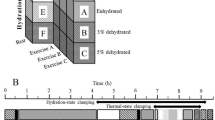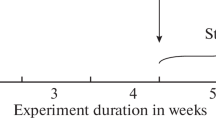Abstract
The effect of external heat-load, exercise and dehydration on dynamic changes in plasma cortisol during the development of heatstroke was investigated. Thirty-three unanesthetized dogs were tested under two sets of climatic conditions: comfort conditions and hot-dry climatic conditions, half of them while exercising. Half of the dogs in each group were rehydrated. None of the dogs that were investigated at room temperature suffered heatstroke. Of the dogs exposed to high ambient temperature, all of the exercising, as well as five out of six non-hydrated dogs and one rehydrated non-exercising dog suffered heatstroke. Significant dehydration (6%–7% of body weight), occurred only under hgh ambient temperature. Plasma cortisol levels of all dogs that suffered heatstroke rose conspicuously for at least 5 h and returned to normal levels 24 h later. Cortisol levels of dogs who did not experience heatstroke remained within the normal range. Cortisol levels correlated with the severity of the stress leading to heatstroke. High and rising levels of cortisol, several hours after body temperature returns to normal, may support the diagnosis of heatstroke.
Similar content being viewed by others
References
Assia E, Epstein Y, Shapiro Y (1985) Fatal heatstroke after a short march at night: a case report. Aviat Space Environ Med 56:441–442
Christison GI, Johnson HD (1972) Cortisol turnover in heat stress in cows. J Anim Sci 35:1005–1010
Collins KJ, Few JD (1979) Secretion and metabolism of cortisol and aldosterone during controlled hyperthermia. J Physiol 292:1–14
Collins KJ, Weiner JS (1968) Endocrinological aspects of exposure to high environmental temperature. Physiol Rev 48:785–839.
Collins KJ, Few JD, Foreward TJ, Giec LA (1969) Stimulation of adrenal glucocorticoid secretion in man by raising the body temperature. J Physiol 202:645–660
Dill DB, Costill DL (1974) Calculation of precentage changes in volume of blood, plasma and red cells in dehydration. J Appl Physiol 37:297–298
Few JD (1974) Effect of exercise on the secretion and metabolism of cortisol in man. J Endocrinol 62:341–353
Follenius N, Brandenberger G, Onyo S, Condas V (1982) Cortisol as a sensitive index of heat intolerance. Physiol Behav 29:509–513
Foss MC, Bernard RC, Tipton LM (1971) Free 11-hydroxycorticoids levels in working dogs as affected by exercise training. Endocrinology 89:96
Francesconi RP, Sawka MN, Pandolf KB (1984) Hypohydration and acclimation effects on hormone responses to exercise/heatstress. Aviat Space Environ Med 55:365–369
Francis KT (1979) Effects of water electrolyte replacement during exercise in the heat on biochemical indices of stress and perormance. Aviat Space Environ Med 50:115–119
Galbo J (1981) Endocrinology and metabolism exercise. Int J Sports Med 2:203–211
Hartley LH, Mason JW, Hogan RP (1972) Multiple hormonal responses to graded exercise in relation to physical training. J Appl Physiol 33:602–606
Hubbard RW, Matthew WT, Lindusk JD, Curtis FC, Bowers WD, Leav I, Mager M (1976) The laboratory rat as a model for hyperthermic syndrome in humans. Am J Physiol 231:1119–1123
Hubbard RW, Bowers WD, Matthew WT, Curtis FC, Criss REL, Sheldon GM, Ratteree JW (1977) Rat model of acute heatstroke mortality. J Appl Physiol 24:809–816
Magazanik A, Shapiro Y, Shibolet S, Sohar E (1977) Effects of temperature and exercise on respiratory metabolism and acid-base balance. Isr J Med Sci 13:327
Shapiro Y, Rosenthal T, Sohar E (1973) Experimental heatstroke, a model in dogs. Arch Intern Med 131:688–692
Shibolet S, Coll R, Gilat T, Sohar E (1967) Heatstroke; its clinical picture and mechanism in 36 cases. Q J Med 36:525–548
Shibolet S, Lancaster MC, Danon Y (1976) Heatstrokes: a review. Aviat Space Environ Med 47:280–301
Sohar E, Michaeli D, Waks U, Shibolet S (1968) Heatstroke caused by dehydration and physical effort. Arch Intern Med 122:159–161
Author information
Authors and Affiliations
Rights and permissions
About this article
Cite this article
Assia, E., Epstein, Y., Magazanik, A. et al. Plasma-cortisol levels in experimental heatstroke in dogs. Int J Biometeorol 33, 85–88 (1989). https://doi.org/10.1007/BF01686283
Received:
Revised:
Accepted:
Issue Date:
DOI: https://doi.org/10.1007/BF01686283




